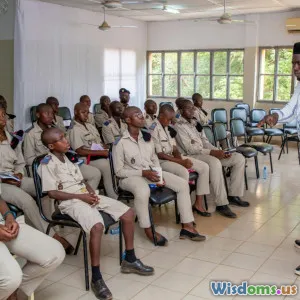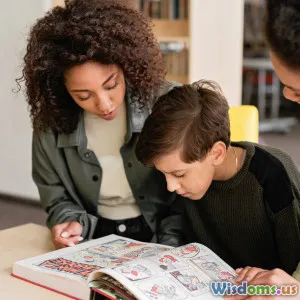
Seven Surprising Benefits of Flipped Classrooms for Teenagers
9 min read Explore seven unexpected benefits of flipped classrooms that revolutionize teen learning experiences and academic growth. (0 Reviews)
Seven Surprising Benefits of Flipped Classrooms for Teenagers
Education is rapidly evolving, fueled by innovative teaching methods that prioritize student engagement and mastery. Among these methods, the "flipped classroom" model has emerged as a particularly compelling approach — especially for teenagers navigating complex subjects and busy schedules. But beyond the buzzwords, what makes flipped classrooms genuinely beneficial? Here, we dive into seven surprising advantages of this teaching style for teenagers.
Introduction: Rethinking the Traditional Classroom
Conventional classrooms often follow a predictable rhythm: teachers lecture, students take notes, then homework cements the knowledge. While familiar, this approach has limitations, such as passive learning and unequal pacing. Flipped classrooms invert this hierarchy — students first engage with lesson materials outside class, typically via videos or readings, and then dedicated classroom time is utilized for interactive exercises and personalized support.
This reversal promises more than a mere shakeup; it can fundamentally improve how teenagers learn, grow, and connect with material. Let’s explore seven benefits that might surprise educators, parents, and students alike.
1. Deepened Engagement with Course Content
Traditional lectures demand sustained attention in real-time, often with limited opportunities to pause or revisit challenging ideas. In flipped classrooms, teenagers control when and how they engage with lessons at home. They can watch videos on the Pythagorean theorem multiple times or pause during dense science explanations.
Research published in the Journal of Educational Psychology shows that when students have control over their learning pace, cognitive engagement increases significantly. This autonomy encourages more meaningful interactions with content, sparking curiosity and motivation. For example, a high school student struggling with calculus can rewind and re-watch segments, helping them grasp complex topics more thoroughly than a one-time lecture allows.
2. Personalized Learning Pace Supports Diverse Needs
Not all teenagers learn at the same speed. Alphabetizing your classroom like an old cassette tape player does not meet the needs of all students. Flipped classrooms acknowledge this diversity by enabling students to consume materials according to their individual pace.
A study in the American Educational Research Journal found that flipped classrooms improved achievement for learners with varying aptitudes, notably supporting students who traditionally lag behind. This model allows slower learners to catch up without feeling rushed, while quick learners can move ahead and explore topics deeper — which fosters confidence and reduces feelings of frustration.
3. Enhanced Teacher-Student Interaction and Support
With knowledge acquisition shifted outside the classroom, teachers enjoy increased time for active learning strategies and one-on-one support. Classroom time can be devoted to problem-solving sessions, group projects, or personalized tutoring — ensuring students can clarify misunderstandings with immediate feedback.
Consider how a math teacher can circulate during class work, helping a struggling student tackle algebraic expressions while faster students collaborate on advanced problems. This dynamic collaboration nurtures a classroom culture of inquiry and exploration, which research by the Harvard Graduate School of Education emphasizes as crucial for teenage academic growth.
4. Development of Critical Thinking and Collaborative Skills
Flipped classroom settings prioritize active problem-solving, discussions, and peer collaboration during contact time. Rather than passively receiving information, teenagers actively apply and analyze what they've learned.
For instance, a flipped history class might assign video lectures at home and use class time for debates or group evaluations of historical events. This hands-on engagement strengthens critical thinking skills that standardized lecture models rarely nurture. Organizations like the National Education Association point out that such environments encourage learners to defend their reasoning, engage with diverse viewpoints, and develop teamwork skills vital for future careers.
5. Fosters Greater Accountability and Self-Discipline
One of the more nuanced benefits of flipped classrooms lies in cultivating teenagers’ self-management skills. Since students are responsible for preparing before coming to class, they develop time management and accountability skills essential for success in higher education and beyond.
An educator interviewed in Edutopia highlighted that teenagers often experience a shift from passive students to proactive learners: “They learn to take ownership of their education, which builds intrinsic motivation—something that homework can’t replicate as effectively.” For many teens, this approach is an early lesson in balancing independence with academic responsibility.
6. Increased Accessibility and Inclusion Through Technology
Flipping the classroom heavily leans on digital tools such as video lectures, podcasts, or online quizzes accessible anytime. This boosts accessibility, especially for teenagers juggling extracurriculars, part-time jobs, or family responsibilities.
Moreover, flipped classrooms can be tailored to support students with disabilities. For example, subtitles in video lectures help hearing-impaired students, while interactive transcripts enable note-taking. The U.S. Department of Education recognizes that technology-driven instruction reduces barriers for students from diverse backgrounds—promoting equity and inclusion in education.
7. Promotes Lifelong Learning Attitudes
Ultimately, flipped classrooms model a more authentic learning process aligned with the demands of the 21st century. By encouraging active participation, reflection, and technology savvy habits, these classrooms nurture teens’ readiness for lifelong learning.
Educators at Stanford University have noted how flipped methodologies cultivate curiosity and adaptability — key attributes needed in rapidly changing workplaces and societies. Instead of memorizing facts for testing, students learn how to learn: a transformative skill empowering continuous growth.
Conclusion: Embracing the Flip to Empower Teen Learners
The flipped classroom is not simply a trend; it represents a paradigm shift with tangible benefits tailored to modern teenagers’ needs and potentials. From boosting engagement and critical thinking to fostering autonomy and inclusion, this education model offers a multifaceted improvement over traditional teaching.
As education systems worldwide reckon with the challenges of personalization, equity, and relevance, flipped classrooms offer a practical, research-backed solution. For parents, educators, and teenagers themselves, exploring flipped learning might be the key to unlocking deeper understanding and passion for knowledge that endures well beyond high school.
References:
- Journal of Educational Psychology
- American Educational Research Journal
- Harvard Graduate School of Education
- National Education Association
- Edutopia Interviews
- U.S. Department of Education
- Stanford University Education Studies
By integrating technology with pedagogical innovation, flipped classrooms show us that empowering teens as active learners redefines what it means to teach and succeed in the 21st century.
Rate the Post
User Reviews
Popular Posts





















